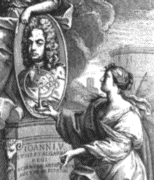

In the iconography Urania is often depicted as a young woman in a placid
appearance, dressed with a blue gown (named ortostadia, a Greek name
indicating a straight tunic) and a wide belt, like tragic actors. Her head is
crowned with stars, and she holds her attributes, which are the celestial globe and
the bar, called radius.
The historian of mythology W.H. Roscher points out that Urania is the only Muse to
have univocal attributes, that cannot be exchanged with those belonging to her
sisters. He particularly refers to Urania's globe, which is to be considered
among the first three-dimensional representations of the celestial sphere, that
was generally depicted as a disk.
In the iconography accompanying the astronomical treatises of the XVIIth,
XVIIIth and XIXth centuries, the image of Urania loses some of the attributes
previously linked to her figure, such as the globe and the bar. She begins to
assume the more generic look of a young woman surrounded by astronomical
instruments (armillary spheres, telescopes, compasses), while the background
becomes less generic and shows astronomical elements, such as Observatories,
towns (since the Ephemerides are always referred to the longitude of a
particular town), particular instruments.
Hesperi et Phosphori nova phaenomena sive observationes circa planetam Veneris.
Romae, apud Ioannem Mariam Salvioni, 1728.
pp. [2], VII, 92, [2], 9 plates. f°.
DCC - f° - 14
Lalande
 In the frontispiece
of the book by Francesco Bianchini a young woman is
depicted, wearing a wide gown and handing an astronomical instrument to the
portrait of the King of Portugal; her foot is placed near a telescope, a sheet
with astronomical calculations and a pair of compasses.
The engraving is a metaphor of the King's glory, sung by the angel with a
trumpet hanging over Minerva on the throne, who wears a helmet and keeps an arm
on the King's portrait. A figure of Atlas supports the celestial globe, on which
some constellations can be recognized, while a winged putto offers the King the
globe of Venus.
In the frontispiece
of the book by Francesco Bianchini a young woman is
depicted, wearing a wide gown and handing an astronomical instrument to the
portrait of the King of Portugal; her foot is placed near a telescope, a sheet
with astronomical calculations and a pair of compasses.
The engraving is a metaphor of the King's glory, sung by the angel with a
trumpet hanging over Minerva on the throne, who wears a helmet and keeps an arm
on the King's portrait. A figure of Atlas supports the celestial globe, on which
some constellations can be recognized, while a winged putto offers the King the
globe of Venus.
The frontispiece was made by Rocco Pozzi (d. 1780) and Stefano Pozzi (Rome 1707-1768); the former is known as copper engraver from the school of Frezza, while the latter was a painter, follower of Carlo Maratta, famous for his mythological scenes in a country environment. Stefano Pozzi used to work in Rome, where he became member of the Academy of St.Luke and of the Congregazione dei Virtuosi, of which he became president in 1742.
Francesco Bianchini (Verona 1662-1729) worked in Rome as Superintendent at the Fine Arts and Secretary of the Congregation of the Calendar, at the court of Cardinal Ottoboni, then Pope Alexander VIII. He wrote a treatise about the calendar (De Kalendario et cyclo Caesaris), of noticeable historical and scientific importance, and a dissertation concerning the chronological problem of the date of the Easter.
In the Bologna Astronomical Museum there is a globe of Venus made by Francesco Bianchini, with a wooden base simpler than that appearing in the frontispiece.



| Biblioteca del Dipartimento di Astronomia Pierluigi Battistini, Laura Peperoni e Marina Zuccoli |